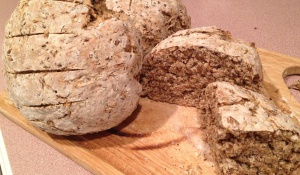It’s been a while since I’ve been in the lab. Months, in fact; we can chalk my weekend foray into beer brewing up to my desire to get back to the bench. And what better time to cook up a festive ale than the start of the holiday season? So, let’s talk about beer (brewing).
Beer is truly an incredible social construct which evolved over the last 9000 or so years. Prehistoric Chinese cultures developed small-scale brewing operations before they even came up with writing. That’s right; humans were imbibing beverages of choice well before the pyramids were constructed in Egypt, before there was even an Egyptian civilization in which to build pyramids. An abbreviated history of mankind would read as follows (in order): agriculture, animal domestication, beer, writing, lots of messy wars, moon landing. Priorities.
To make grain alcohol, you need yeast and sugar; everything else is simply icing on the proverbial cake. Most likely this was discovered accidentally when the grain store of some prehistoric civilization was infected with wild yeast.
But what is yeast, and why is it so important in brewing? Yeast is a common name for any of the 1,500 or so species of eukaryotic fungi belonging to the order Saccharomycetales. That’s taxonomy speak for fungi that break down sugar. Simply put, yeast cells take sucrose (table sugar), and using an enzyme called invertase, cleave the glycosidic bond between them. This process results in two monosaccharide sugars, glucose and fructose.
You may notice a similarity between glucose and fructose, namely they have exactly the same number of carbon, oxygen, and hydrogen atoms composing them. Both molecules can be written using the same molecular formula, C6H12O6 and are called structural isomers. This is convenient, since both sugars are converted to ethanol and carbon dioxide in the next step of fermentation, allowing us to write a single formula without violating any pesky conservation of mass laws. A second enzyme in yeast, called zymase, is responsible for converting hexose sugars into alcohol and carbon dioxide.
So, you’ve got some yeast and you can add some sugar water to it, this will indeed make alcohol. Unfortunately, it will not make beer. What makes beer beer is the use of malted barley or wheat as a source of sugar. Cereal grains impart specific flavors to a beer: oatmeal gives a sweet flavor, barley makes a brew smokey and gives notes of coffee, and wheat will impart honey sweetness. The next major characteristic of beer is hop content. Hops are buds of hop plant, and grow in different strains. Hops impart bitterness to beer. Ever tasted an India Pale Ale (IPA)? The first thing you’ll notice is the aggressive hop flavoring and strong bitterness. Contrast that flavor with the sweetness of an oatmeal stout or most porters, which have limited hop content.
Alas, maybe you’re not interested in the science of beer. Maybe you came here hoping I’d share a beer brewing 101 tutorial. Well, I’d hate to disappoint; click here for an excellent first timer brew, with very detailed instructions on how to brew!
And what’s left to do with the spent grain from brewing? Why, use similar chemistry to make brewer’s bread, of course!
Cheers!
Mitchell




Reblogged this on Filthy Peasant and commented:
I find this kind of shit fascinating.
Dude totally up my alley. Loved the Organic Chemistry behind the brewing. So genetic engineering would create yeast with more efficient enzymes?